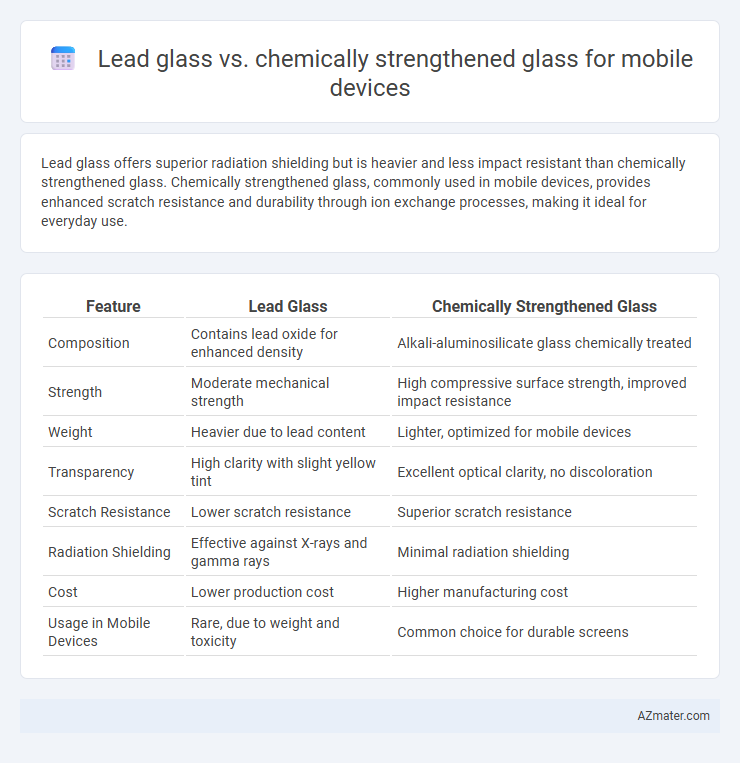Lead glass offers superior radiation shielding but is heavier and less impact resistant than chemically strengthened glass. Chemically strengthened glass, commonly used in mobile devices, provides enhanced scratch resistance and durability through ion exchange processes, making it ideal for everyday use.
Table of Comparison
| Feature | Lead Glass | Chemically Strengthened Glass |
|---|---|---|
| Composition | Contains lead oxide for enhanced density | Alkali-aluminosilicate glass chemically treated |
| Strength | Moderate mechanical strength | High compressive surface strength, improved impact resistance |
| Weight | Heavier due to lead content | Lighter, optimized for mobile devices |
| Transparency | High clarity with slight yellow tint | Excellent optical clarity, no discoloration |
| Scratch Resistance | Lower scratch resistance | Superior scratch resistance |
| Radiation Shielding | Effective against X-rays and gamma rays | Minimal radiation shielding |
| Cost | Lower production cost | Higher manufacturing cost |
| Usage in Mobile Devices | Rare, due to weight and toxicity | Common choice for durable screens |
Introduction to Lead Glass and Chemically Strengthened Glass
Lead glass, known for its high refractive index and density, enhances clarity and brilliance in mobile device displays but is heavier and less impact-resistant. Chemically strengthened glass undergoes an ion-exchange process, replacing smaller ions with larger ones to create surface compressive stress, significantly improving scratch resistance and durability. Both materials serve distinct roles in mobile technology, balancing optical performance and mechanical strength to meet device requirements.
Composition and Manufacturing Processes
Lead glass contains a high percentage of lead oxide (PbO), enhancing its density and refractive index, produced through traditional melting and slow cooling processes. Chemically strengthened glass, commonly used in mobile devices, undergoes an ion-exchange process where smaller sodium ions in the glass surface are replaced by larger potassium ions, creating a compressive stress layer that improves strength without altering the composition significantly. The manufacturing of chemically strengthened glass involves precise temperature control during immersion in molten potassium salt baths, contrasting with the simpler melt-quench method used for lead glass.
Key Physical Properties Compared
Lead glass exhibits higher density and refractive index compared to chemically strengthened glass, enhancing its optical clarity yet increasing weight. Chemically strengthened glass offers superior surface compressive stress due to ion exchange processes, resulting in enhanced scratch resistance and impact strength crucial for mobile device durability. Thermal expansion in lead glass is generally higher, making chemically strengthened glass more stable under temperature variations commonly encountered in mobile use.
Strength and Durability Analysis
Lead glass offers moderate strength but is primarily valued for its optical clarity rather than durability, making it less suitable for mobile devices prone to impact. Chemically strengthened glass undergoes an ion-exchange process that increases surface compression, significantly enhancing its resistance to scratches, drops, and bending forces commonly experienced by smartphones. This process results in a more durable and resilient glass, providing superior protection for mobile device displays compared to lead glass alternatives.
Performance Under Impact and Stress
Lead glass offers high density and excellent radiation shielding but is more brittle and prone to cracking under impact compared to chemically strengthened glass. Chemically strengthened glass, commonly used in mobile devices, undergoes ion exchange that increases surface compressive stress, significantly enhancing its resistance to scratches, impacts, and bending stress. This process results in superior durability and performance under drop tests and daily mechanical stress, making chemically strengthened glass the preferred choice for mobile device screens.
Optical Clarity and Display Quality
Lead glass offers high refractive index and excellent light dispersion, enhancing optical clarity with vivid color reproduction for mobile displays. Chemically strengthened glass provides superior scratch resistance and durability but may cause slight light diffusion, potentially affecting display sharpness under certain angles. For devices prioritizing vibrant, sharp visuals, lead glass excels, while chemically strengthened glass balances durability with good optical performance.
Weight and Device Design Implications
Lead glass typically exhibits higher density due to its lead content, resulting in increased weight for mobile devices compared to chemically strengthened glass. Chemically strengthened glass, such as aluminosilicate variants, offers superior strength-to-weight ratios, enabling manufacturers to design slimmer, lighter devices without compromising durability. This reduction in weight significantly enhances user comfort and allows for more innovative, sleek device designs tailored to modern ergonomic standards.
Environmental and Health Considerations
Lead glass contains high levels of lead oxide, raising concerns about toxic lead exposure during manufacturing and disposal, which can contaminate soil and water and pose serious environmental and health risks. Chemically strengthened glass uses ion-exchange processes without harmful heavy metals, making it safer to produce and recycle, reducing environmental impact and minimizing health hazards for workers and users. The absence of toxic elements in chemically strengthened glass supports sustainable mobile device manufacturing and aligns better with environmental regulations.
Cost and Availability in the Industry
Lead glass generally has higher production costs due to the use of lead oxide, which also restricts its availability because of environmental regulations. Chemically strengthened glass, commonly used in mobile devices, offers a more cost-effective and widely accessible solution with scalable manufacturing processes. The mobile industry favors chemically strengthened glass for its balance of strength, affordability, and compliance with safety standards.
Choosing the Right Glass for Mobile Devices
Lead glass offers excellent clarity and weight, but its higher density makes it less ideal for sleek mobile devices compared to chemically strengthened glass. Chemically strengthened glass, such as Gorilla Glass, provides superior scratch resistance and impact durability due to ion exchange processes, enhancing mobile device longevity. Prioritizing chemically strengthened glass ensures optimal balance of strength, thinness, and optical transparency critical for modern smartphones and tablets.

Infographic: Lead glass vs Chemically strengthened glass for Mobile device
 azmater.com
azmater.com